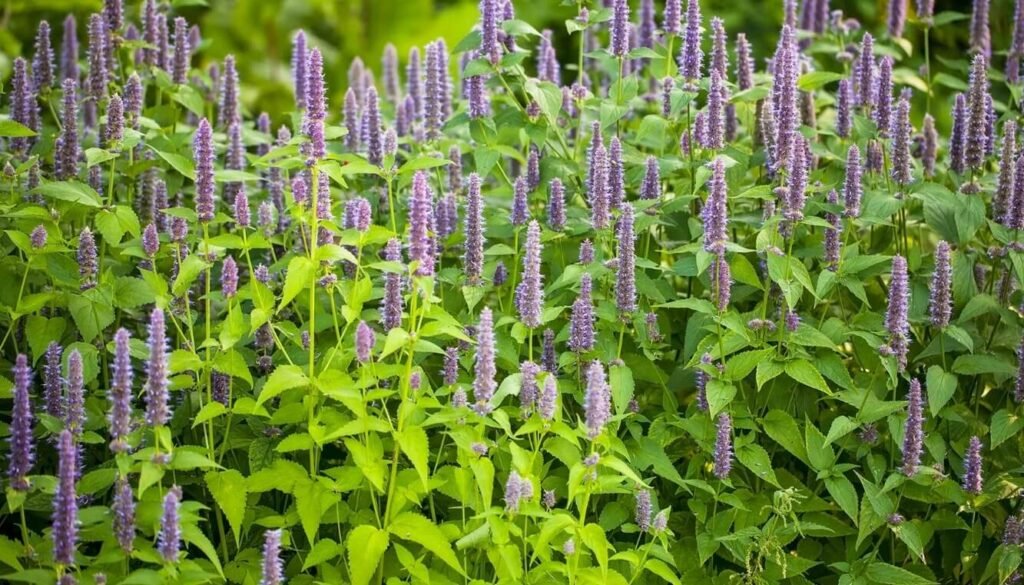Anise hyssop (Agastache foeniculum) is a versatile and aromatic herbaceous perennial that adds beauty and fragrance to gardens while attracting pollinators like bees and butterflies. In this comprehensive guide, we’ll explore everything you need to know about cultivating and caring for anise hyssop, from its history and propagation to harvesting and preserving its blooms.
Cultivation and History
agastache foeniculum, is native to North America, where it has been used for centuries by Indigenous peoples for its medicinal and culinary properties. The plant belongs to the mint family (Lamiaceae) and is closely related to both anise and hyssop, hence its common name. Anise hyssop is prized for its licorice-scented leaves and spikes of lavender-blue flowers, which bloom from midsummer to fall.
Propagation
Anise hyssop can be propagated by seeds or division.
Seeds:
- Sow seeds indoors in early spring, about 6-8 weeks before the last frost date.
- Cover seeds lightly with soil and keep them moist until germination, which typically takes 10-14 days.
- Transplant seedlings outdoors after the danger of frost has passed, spacing them 12-18 inches apart.
Division:
- Divide established plants in early spring or fall.
- Dig up the plant and carefully separate the root ball into smaller sections, each with several shoots.
- Replant divisions at the same depth as the original plant, spacing them according to their mature size.
How to Grow
Sunlight:
Anise hyssop thrives in full sun but can tolerate partial shade, especially in hotter climates.
Soil:
Plant anise hyssop in well-draining soil with a neutral to slightly alkaline pH. Amending the soil with compost or aged manure before planting can improve fertility and drainage.
Watering:
Keep the soil evenly moist, especially during the plant’s first growing season. Once established, anise hyssop is drought-tolerant and requires less frequent watering.
Growing Tips
- Mulch: Apply a layer of mulch around the base of the plant to retain moisture and suppress weeds.
- Deadhead: Remove spent flowers regularly to encourage continuous blooming and prevent self-seeding.
- Fertilize sparingly: Anise hyssop doesn’t require much fertilization. A light application of balanced fertilizer in spring is usually sufficient.
Maintenance
Anise hyssop is relatively low-maintenance but benefits from occasional pruning to promote bushy growth and remove dead or damaged stems.
- Prune the plant back by one-third in early spring to encourage new growth.
- Cut back spent stems to the base of the plant throughout the growing season to maintain its shape and appearance.

Cultivars to Select
Several cultivars of anise hyssop are available, each with its own unique characteristics:
- ‘Blue Fortune’: A compact variety with lavender-blue flowers and a more upright growth habit.
- ‘Golden Jubilee’: This cultivar features chartreuse foliage that adds a pop of color to the garden.
- ‘Black Adder’: Known for its dark purple flower spikes and strong licorice scent.
Managing Pests and Disease
Anise hyssop is relatively pest and disease-resistant but may occasionally encounter problems such as aphids, spider mites, or powdery mildew. Here’s how to manage common issues:
- Aphids and spider mites: Spray plants with a strong stream of water to dislodge pests, or use insecticidal soap as needed.
- Powdery mildew: Ensure good air circulation around plants and avoid overhead watering. Fungicidal sprays may be necessary in severe cases.
Best Garden Uses
Anise hyssop is a versatile plant that can be used in various garden settings:
- Herb garden: Plant anise hyssop alongside other culinary herbs like basil, thyme, and sage.
- Pollinator garden: The fragrant flowers attract bees, butterflies, and other beneficial insects.
- Border or container: Use anise hyssop as a colorful border plant or in containers on patios and decks.
Harvesting and Preserving
Both the leaves and flowers of anise hyssop are edible and have a sweet, licorice-like flavor. Here’s how to harvest and preserve them:
- Leaves: Harvest young leaves for fresh use in salads, teas, or desserts. Dry larger leaves for later use in teas or seasoning blends.
- Flowers: Harvest flower spikes when they are fully open for use in teas, potpourri, or as a garnish.
Quick Reference Growing Guide
| Aspect | Full sun to partial shade |
|---|---|
| Soil | Well-draining, neutral to slightly alkaline |
| Watering | Evenly moist, drought-tolerant once established |
| Maintenance | Prune in spring, deadhead spent flowers |
By following these guidelines, you can enjoy the beauty and benefits of anise hyssop in your garden for years to come.
FAQ
Can I grow agastache foeniculum in a container?
Yes, agastache foeniculum can be grown in containers, provided they have well-draining soil and receive adequate sunlight.
Is agastache foeniculum invasive?
agastache foeniculum can self-seed under favorable conditions but is not considered invasive. Deadheading spent flowers can help prevent excessive self-seeding.
How do I dry anise hyssop for later use?
To dry anise hyssop leaves, hang bundles upside down in a warm, well-ventilated area until they are crisp. Store dried leaves in an airtight container away from light and moisture.

